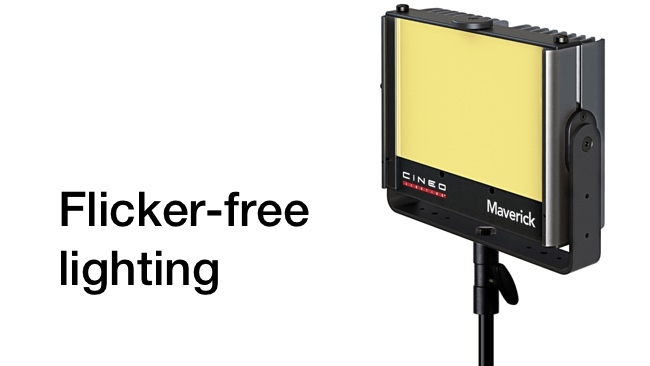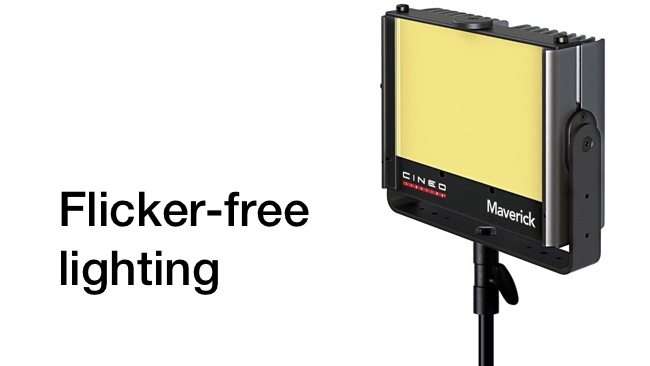

Ned Soltz recently had cause to use a Cineo Maverick on a shoot and was rather impressed by what he found. As he says, lighting tech has come a long way...
Lighting technology has come a long way in the past few years. I was an early adopter of LED lighting, discovering all too quickly that I needed to gel every single light with minus-green in an effort to eliminate that horrible green spike. In fact, I recall setting up an original Litepanels 1x1 side by side with a Chinese clone 1x1 and I didn’t need a Vectorscope to see the green from the clone and even to some degree from the original name-brand item.
You might also remember that around 2008 Litepanels sued in US courts a number of LED manufacturers, prevailing in that patent infringement case in 2013. LED manufacturers were then either obligated to pay royalties to Litepanels or cease importation into the US.
But this ruling excluded two specific LED variants—RGB and Remote Phosphor lighting.
And this leads me to the topic at hand—Cineo Lighting and their line of Remote Phosphor fixtures.
Remote Phosphor is based around a high intensity Blue LED within the fixture enclosure with a phosphor-embedded interchangeable front panel. The Blue LED emits phosphor-exciting photons at specific wavelengths to deliver pure color across the complete spectrum. This creates light that is not only high CRI but also faithful to the spectrum.
Cineo Lighting produces Remote Phosphor lighting in a variety of sizes and I recently shot a simple 1-shot interview using a Cineo Maverick as a keylight and a Cineo Matchbox for fill. It was my intent to use another Matchbox as a hair light but I was fortunate enough to have a window with muted sunshine for a partly cloudy day that did the trick while a couple of practicals in the subject’s living room lit the background adequate to the task.
Remote Phosphor lights are not continuously-adjustable color temps as pure LED lighting. Cineo ships their lights with easily-interchanged 3200K and 5600K panels. A 2700K, 4300K or 6300K panel can be purchased separately.
The Maverick weighs in a 4.9lbs (2.2 kg) and is a compact 9.4” x 7.3” x 3” (240mm x 186mm x 78mm) yet from that small package can output up to 8000 lumens. It is dimmable from 0-100% with no color change and can be powered either by AC mains or battery power. Power consumption is configurable from 75 to 120 watts.
Cineo makes a few claims in their publicity and just a few hours with the light confirms those claims. Lighting is absolutely flicker free. There are no spikes (at least nothing that I or my Vectorscope could see). The light wraps softly around subject. And now this is a subjective assessment—I found using the Maverick as a key light to produce softer light than a conventional LED but not as soft as flourescents. That happened to be ideal for my interview where I wanted a little harder light. But Cineo has an optional softbox which I didn’t have, and optional barn doors which I did have to enable me to direct the light. I had brought some diffusion material through which to shoot but decided I didn’t need it.
Built like a tank
The Maverick is built like a tank. The larger case acts as an effective heat sink and kept the fixture cool through 3 hours of continuous use. This precludes the need for a fan. While I only adjusted intensity manually, DMX option exists.
And one great little feature. The AC power cord is locking so no fears of pulling the plug while shooting.
A Cineo Maverick kit with 3200K and 5600K panels as well as either V mount or Gold Mount plate retails under $2300. AC adapters are under $300. This positions the Maverick in the same range as other professional lights and represents, I believe, excellent value.
The Cine Matchbox is an under $500 fixture with an output of up to 1000 lumens suitable as an on-camera light or as I did on this shoot for a fill light. Like the Maverick, it can be powered by AC or DC with appropriate adapter, is adjustable from 0-100% intensity and employs the same Remote Phosphor technology with the interchangeable front plates. It also comes with 3200K and 5600K phosphor screens.
Cineo a small Matchstick fixture which by its name should be self explanatory. While I was not able to test the Matchstick, I would presume the same results because the technology is the same. Matchstick would be particularly useful if, for example, my interview were of a busy executive at their desk with little time or space for a major lighting set up.
I would definitely recommend the Cineo Lighting Remote Phosphor line for durability, accurate color, portability and general “look, texture and feel” of the resultant light.
Tags: Production



Comments